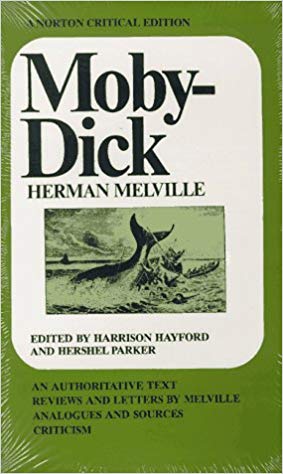
Moby Dick is one of those classics everyone knows but few have ever read. We know it because it has given us iconic images that have sunk to the rock bottom of our culture: the whale; the whiteness of the whale; Ahab’s rage; Queequeg worshiping before his idol; and the opening line: “Call me Ishmael.” We knew these images before we knew the book. As children — or at least as boys — we smirked when we heard the title. Moby Dick. We changed it to Moby’s Dick. We made cracks about penises. We thought it was fun, rebellious even, to say crude things about classic literature. Moby Dick was like a parent. We assumed it wasn’t listening, that it couldn’t possibly understand the words we used, had never used them when it was young, was strangely innocent although older than us.
And then we grew up. We discovered that our parents had known all along about these things. In the same way, we read Moby Dick and discovered that we were never pulling one over on the old book when we cracked jokes about Moby’s Dick. It knew all along:
Chapter 95 – The Cassock
Had you stepped on board the Pequod at a certain juncture of this post-mortemizing of the whale; and had you strolled forward nigh the windlass, pretty sure am I that you would have scanned with no small curiosity a very strange, enigmatical object, which you would have seen there, lying along lengthwise in the lee scuppers. Not the wondrous cistern in the whale’s huge head; not the prodigy of his unhinged lower jaw; not the miracle of his symmetrical tail; none of these would so surprise you, as half a glimpse of that unaccountable cone,—longer than a Kentuckian is tall, nigh a foot in diameter at the base, and jet-black as Yojo, the ebony idol of Queequeg. And an idol, indeed, it is; or, rather, in old times, its likeness was. Such an idol as that found in the secret groves of Queen Maachah in Judea; and for worshipping which, King Asa, her son, did depose her, and destroyed the idol, and burnt it for an abomination at the brook Kedron, as darkly set forth in the 15th chapter of the First Book of Kings.
Look at the sailor, called the mincer, who now comes along, and assisted by two allies, heavily backs the grandissimus, as the mariners call it, and with bowed shoulders, staggers off with it as if he were a grenadier carrying a dead comrade from the field. Extending it upon the forecastle deck, he now proceeds cylindrically to remove its dark pelt, as an African hunter the pelt of a boa. This done he turns the pelt inside out, like a pantaloon leg; gives it a good stretching, so as almost to double its diameter; and at last hangs it, well spread, in the rigging, to dry. Ere long, it is taken down; when removing some three feet of it, towards the pointed extremity, and then cutting two slits for arm-holes at the other end, he lengthwise slips himself bodily into it. The mincer now stands before you invested in the full canonicals of his calling. Immemorial to all his order, this investiture alone will adequately protect him, while employed in the peculiar functions of his office.
That office consists in mincing the horse-pieces of blubber for the pots; an operation which is conducted at a curious wooden horse, planted endwise against the bulwarks, and with a capacious tub beneath it, into which the minced pieces drop, fast as the sheets from a rapt orator’s desk. Arrayed in decent black; occupying a conspicuous pulpit; intent on bible leaves; what a candidate for an archbishoprick, what a lad for a Pope were this mincer!
As an afterthought, note the word “archbishoprick”. In the gutenberg edition, the word is “corrected” by spelling it without a “k”. Melville originally used the archaic spelling. As my Norton Critical Edition points out, this gives us a pun which was lost when gutenberg’s tinkerers tried to improve things.
Update: By a strange alignment of the stars, Salon has just posted an article on the world’s largest penis collection.